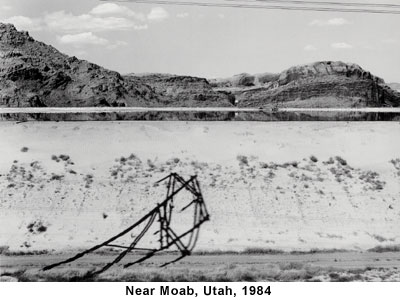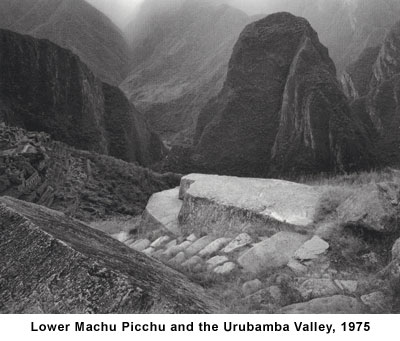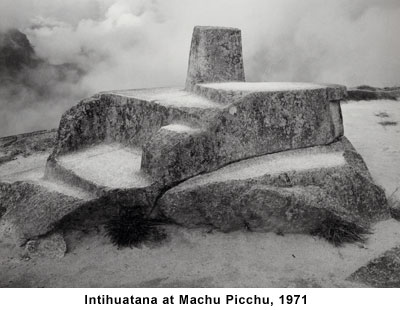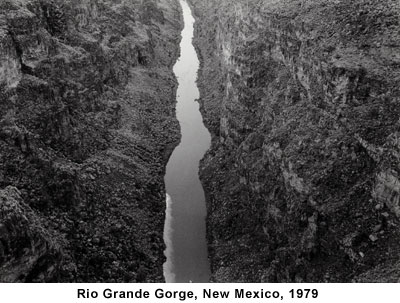Class News
Ed Ranney '64 Photographic Exhibit
The following article is from the New York Times of March 16, 2003. It describes an exhibit of Edward Ranney's photographs in the Princeton University Art Museum, through June 7, 2003. Some of the photographs are displayed at the bottom of this article.
Going Farther Than the Eye Can See
by Benjamin Gennochio
I haven't been to Machu Picchu for
years. The last time was in the 1980s, when I was little more than a pup.
Sneaking away from a family gathering in Bucaramanga, a town in Colombia, I
hitched a ride south to sample Peru's abundance of ruins and remains. And
what a trip it was.
Machu Picchu is perched on a steep-sided ridge surrounded by lofty peaks.
Thousands of feet below, the Urubamba river carves its way through a gorge
that winds around the base of the mountain. Time stood still here, it seemed
all those years ago.
Edward Ranney's photographs of Machu Picchu at the Princeton University Art
Museum evoke the mystical beauty of the old Inca ruin, at least as I recall
it. They also form the core of a larger exhibition celebrating the life and
work of this gifted American photographer. It is the first show to follow
his career from start to present.
Mr. Ranney, 61, grew up in Illinois. He began making photographs at college,
where he studied art history, Spanish and English literature. After
graduation, he traveled to Peru on a scholarship to study the Quechua
Indians around Cuzco. Here, he fell in love with the country's rich cultural
heritage and resolved to become a photographer. His talent has been slowly
percolating ever since.
Mr. Ranney belongs to a tradition of landscape photographers that includes
Frederick Sommer, Paul Caponigro, Aaron Siskind, Wynn Bullock, and Minor
White. What Ranney shares with this distinguished if loose-knit bunch is the
resolve to make photographs whose meaning transcends what you see in the
picture. Imagery is important for him, but only insofar as it conveys
deeper, frequently spiritual themes and ideas.
Mr. Ranney's photographs of Machu Picchu exemplify his efforts to make the
medium speak of things beyond what you and I can see. Deceptively simple in
appearance, pictures such as "Machu Picchu (Intihuatana)," 1971, and "Machu Picchu (Lower Machu Picchu and the Urubamba Valley)," 1975, strive to convey
the intimate connections between Inca monuments and the awesome setting with
its shapely mountain peaks. Photography, for Mr. Ranney, is all about
capturing the character and natural flavor as much as the look of a place.
Also spectacular, in a mysterious sort of way, are his photographs of Peru's
high-altitude desert country. "Taukachi-Konkan, Casma Valley," 1994, is
among the best of them, contrasting the remains of a once thriving Indian
settlement with an arid expanse of open valleys and desert plains. There is
little to fix your eyes on here, but the unrelenting emptiness of it all has
a charge that can shock.
"Taukachi-Konkan, Casma Valley" was shot from a well chosen vantage point
with, I guess, a 5 by 7 inch camera and a wide-angle lens. The format gives
the image an elongated and expansive quality reminiscent of panoramic travel
and expeditionary photography of the 19th century. Mr. Ranney's strategy is
to whet our interest with an exotic vista while working on our unconscious
with stirring, even mournful details of a vanished civilization.
There is a matter-of-factness to Mr. Ranney's pictures that attracts me.
It's also what sets him apart from most travel photographers, including
tourists. Mr. Ranney is not looking for the photogenic, for images he might
convert into souvenirs. He is responding to places that arouse his
"intellectual curiosity" as much as his "visual sensibility", to quote Peter
Bunnell from the exhibition catalog.
Such a quality pervades his photographs of the American Southwest, where he
has lived since the early 1970's. These images trace the history of
settlement throughout the region, from the ghostly remains of Native
American camps to the remnants of towns established by the Spanish four
centuries ago. Other photographs detail the intrusion of modern society and
some local earth works.
"Near Moab, Utah," 1984 (shown just below), is one of the more beguiling photographs made in
this quiet corner of the country. Devoid of activity, it looks like a dull
desert landscape at first glance. Closer inspection reveals a subtle
metaphor for progress: a reservoir at the foot of moisture-starved hills
suggests a town nearby, as does the shadow of a power transmission tower
resting in the foreground. Suddenly the little scene that you first
approached expands and opens out onto another world. You could almost walk
in and be gone.





